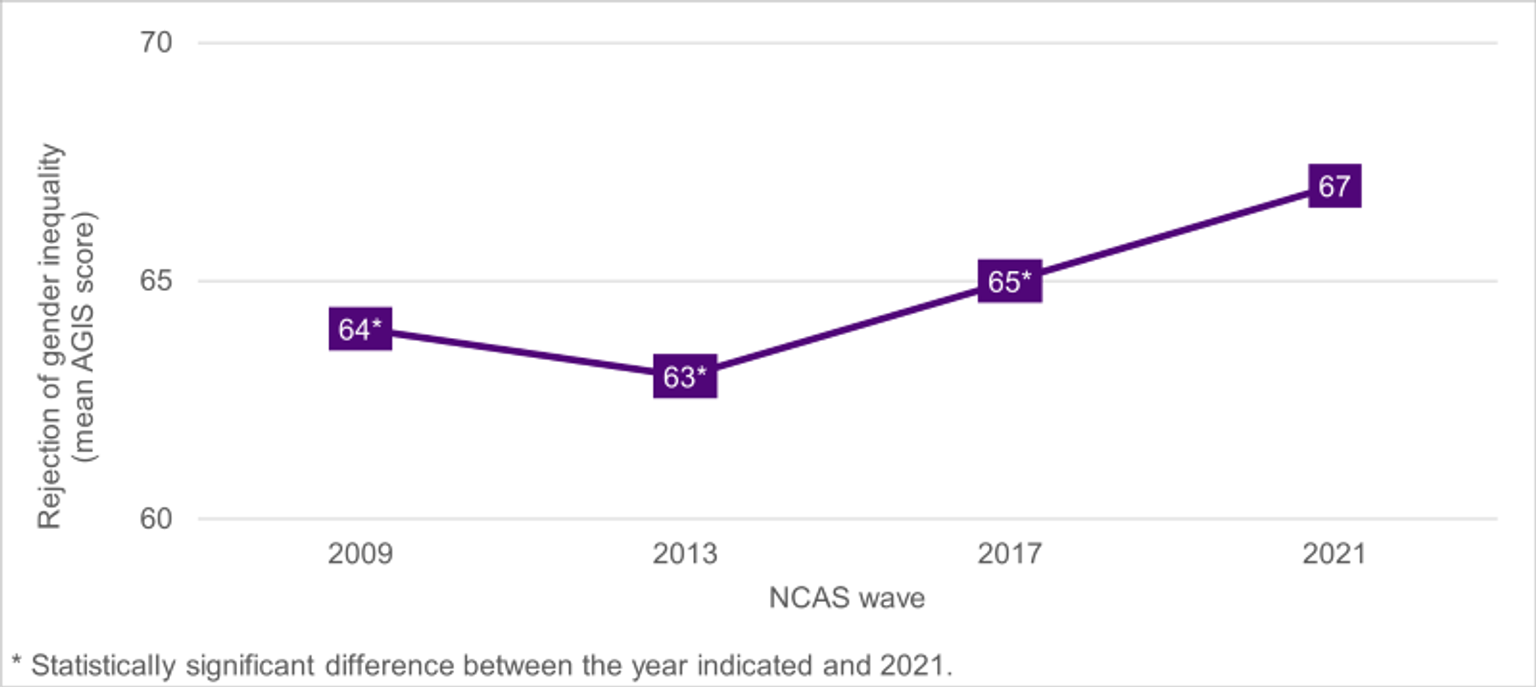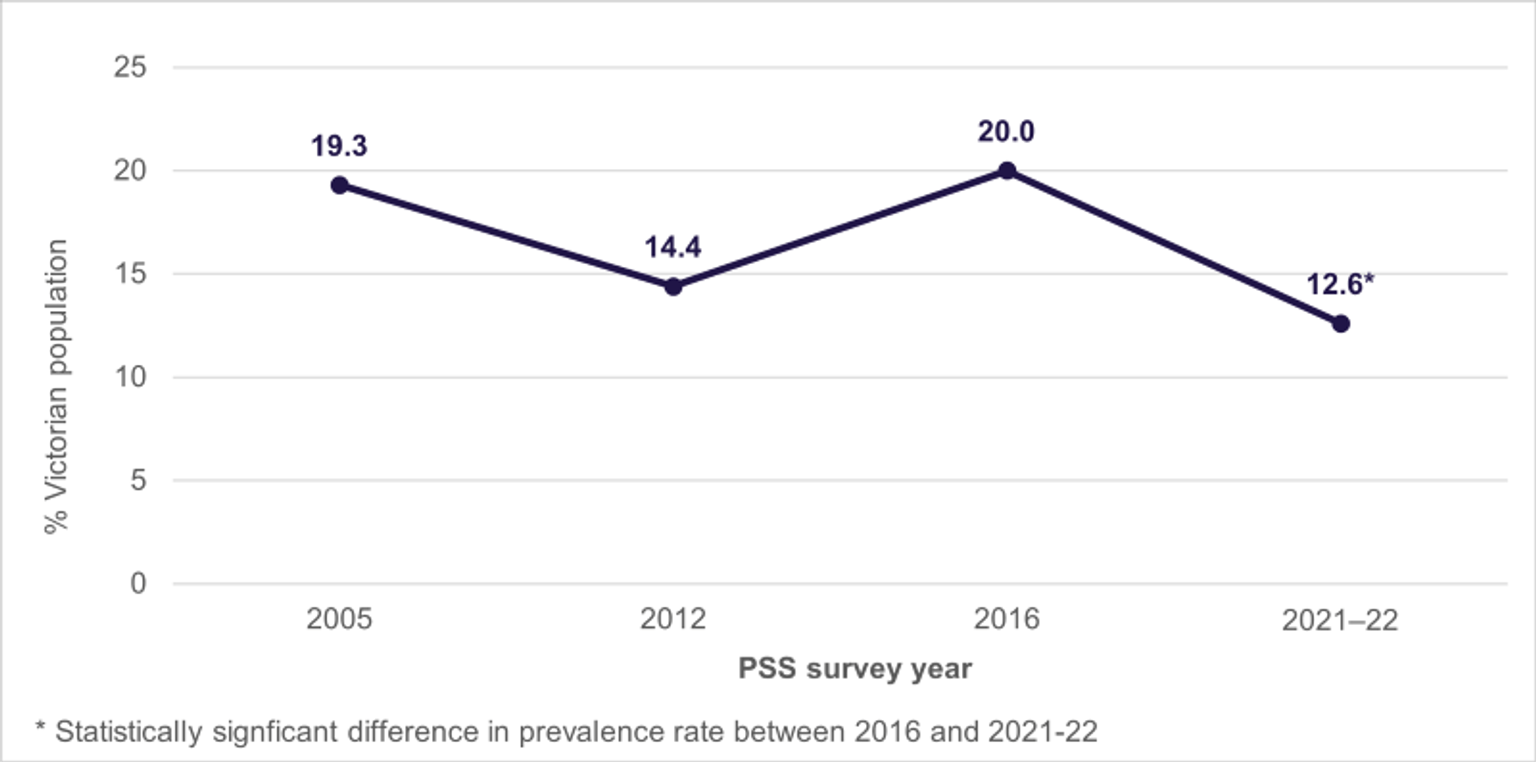Indicator: Decrease in sexist and discriminatory attitudes and behaviours
As noted in Change the story, there is a strong and consistent association between gender inequality and levels of violence against women. Indeed, there are significantly and consistently higher rates of violence against women in countries characterised by gender inequality and poor human rights protections.1
The NCAS shows that the strongest predictor of violence-supportive attitudes and a lower understanding of violence against women is the degree to which respondents hold sexist attitudes.2
Tracking this indicator is important to understand the prevalence of sexist and discriminatory attitudes in Victoria. It also tells us whether efforts to promote attitudes and behaviours that support gender equality are having an impact at the population level.
Measure: Victorian mean score on the Attitudes towards Gender Inequality Scale (AGIS) Scale3
The Attitudes towards Gender Inequality Scale (AGIS), generated through the NCAS, measures rejection of problematic attitudes regarding gender inequality. These include attitudes that reinforce gender roles, undermine women’s leadership in work and public life, limit women’s autonomy in intimate relationships, normalise sexism and deny inequality.
The Victorian mean AGIS score was significantly higher in 2021 compared with 2009, 2013 and 2017 (Figure 1).
This finding indicates a significant increase over time in Victorians’ attitudes that reject gender inequality. This is a positive sign of progress in Victoria, and it is reasonable to suggest that our efforts to advance gender equality and prevent violence against women have contributed to this progress.
The AGIS subscale findings indicate increased rejection by Victorians of attitudes that:
- limit women’s autonomy in intimate relationships (64 per cent in 2009 to 66 per cent in 2021)
- downplay sexism (64 per cent in 2017 and 66 per cent in 2021)
- reinforce traditional, rigid gender roles (66 per cent in 2017 to 67 per cent in 2021).
However, there was no significant improvement in the ‘Undermine leadership’ subscale or the ‘Deny inequality’ subscale between 2017 and 2021, indicating little or no change in attitudes that undermine women’s leadership in work, public life and attitudes that deny gender inequality experiences.
Overall, these results show us that Victoria’s long history of investing in gender equality is having an impact. This foundational work sets a strong base to support our primary prevention efforts to challenge the underlying drivers of gendered violence. It will take some time for the impact of this work to flow through in the form of community-wide changes in attitudes and behaviours.
Indicator: Decrease in prevalence of reported workplace and everyday sexism, sexual harassment, and gender discrimination
Tracking the prevalence of sexism, sexual harassment and gender discrimination in workplaces and everyday settings enables us to see whether these forms of discrimination and violence are decreasing over time. This helps us understand whether our efforts to progress gender equality and prevent violence against women are having an impact.
Tracking these forms of discrimination and violence is also important because they are connected to the drivers of violence against women more broadly, including within families and intimate relationships.
We know that sexual assault is under-reported to Victoria Police. Evidence suggests this is because of mistrust in formal state systems, such as police and the courts, and in workplace processes. Data from the Personal Safety Survey captures family violence perpetrated against victim survivors who may have chosen not to report to police.
Measure: Proportion of Victorian women aged 18 years and over who have experienced sexual harassment (in any setting) in the last 12 months
The rate of sexual harassment against women over a 12-month period has fluctuated since 2005. However, the survey indicates that the percentage of Victorian women who experienced sexual harassment within the 12-month period from 2021–22 is the lowest it has been since the PSS survey began.
Although 2021–22 PSS state and territory results by gender are not yet available, the Australia-wide results show women are almost three times as likely as men to have experienced sexual harassment in the previous 12-months.
Footnotes
1 United Nations Women 2011, In pursuit of justice: progress of the world’s women. UN Women, New York. https://asiapacific.unwomen.org/en/digital-library/publications/2011/1/…
2 Coumarelos C, Weeks N, Bernstein S, Roberts N, Honey N, Minter K and Carlisle E 2023, Attitudes matter: The 2021 National Community Attitudes towards Violence against Women Survey (NCAS), Findings for Australia, research report 02/2023, ANROWS.
3 Note that the wording of this scale in the NCAS has changed since the publication of the Family Violence Outcomes Framework implementation strategy, and the measure here has been adjusted to reflect this.
Updated

